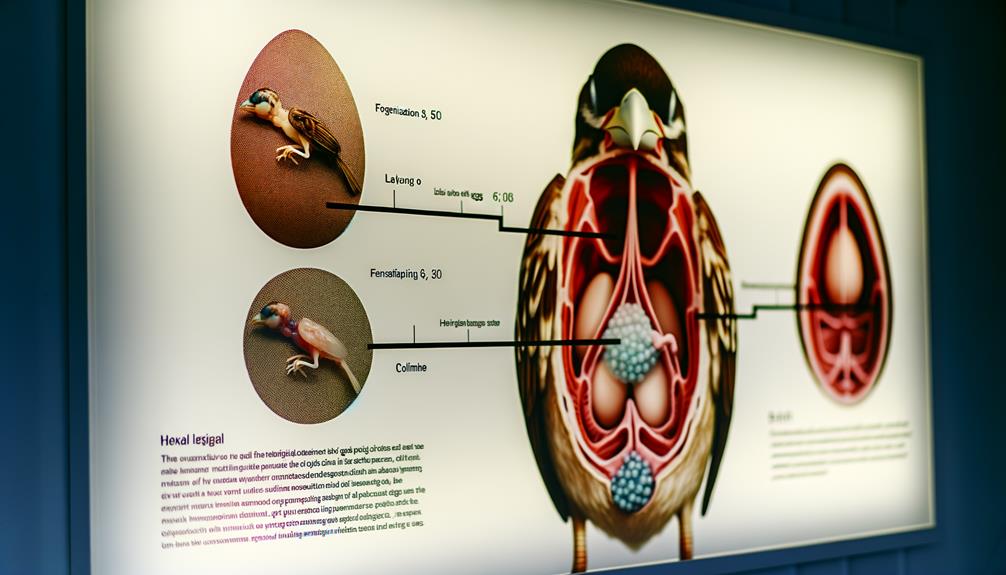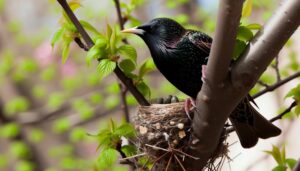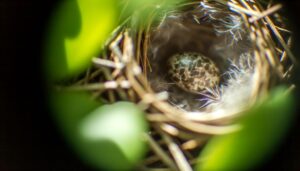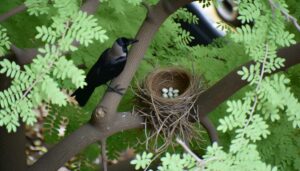How Long After Fertilization Do Sparrows Lay Eggs?
Sparrows generally lay their eggs between 24 to 72 hours after fertilization, with timing influenced by species-specific factors. Following fertilization, a zygote travels through the oviduct, where albumen, membranes, and a calcified shell are sequentially added in a process spanning approximately 24-26 hours.
Environmental factors like temperature and food availability also play pivotal roles in reproductive timing. For instance, House Sparrows typically lay eggs within 24-48 hours post-fertilization, whereas Song Sparrows may take about 48-72 hours.
Variations in these timelines help understand species-specific reproductive strategies and influences. Learn more about the intricate processes involved.

Key Takeaways
- House Sparrows lay eggs approximately 24-48 hours after fertilization.
- Song Sparrows lay eggs around 48-72 hours post-fertilization.
- Egg formation, including shell calcification, takes about 24-26 hours.
- Environmental factors can impact the exact timing of egg-laying.
- Species-specific variations influence the egg-laying timeline after fertilization.
Sparrow Mating Rituals

Sparrow mating rituals involve a complex series of behaviors, including vocalizations, physical displays, and nest-building activities, which are crucial for attracting a mate and securing successful fertilization.
During the breeding season, male sparrows engage in song production to establish territory boundaries and entice females. These vocalizations are often accompanied by physical displays such as wing fluttering and tail fanning, signaling the male's fitness.
Nest-building activities are equally crucial; males typically construct initial nest structures to demonstrate their capability in providing a suitable environment for offspring. Females evaluate these nests for structural integrity and location.
These multifaceted behaviors secure both partners are invested in the reproductive process, thereby increasing the likelihood of successful mating and subsequent fertilization.
Fertilization Process
The fertilization process in sparrows involves the transfer of sperm from the male to the female via cloacal contact, a method known as cloacal kissing. This brief interaction occurs when both birds press their cloacae together, allowing the male to deposit sperm into the female's reproductive tract.
The sperm then travels through the oviduct, where it may encounter an ovum released from the ovary. Fertilization typically occurs in the infundibulum, the upper part of the oviduct. Successful fertilization results in the formation of a zygote, which will subsequently begin its journey through the oviduct, undergoing various developmental stages.
This intricate process ensures genetic material from both parents combines, setting the stage for the eventual formation of an egg.
Egg Formation Timeline

Following successful fertilization, the development of a sparrow egg proceeds through a well-defined timeline within the female's reproductive tract. Initially, the fertilized ovum travels down the oviduct, where it begins the process of albumen (egg white) deposition, typically within 3-5 hours.
Subsequently, the egg's formation continues with the addition of membranes in the isthmus region, lasting approximately one hour. Thereafter, the egg reaches the uterus, where the shell is formed and calcified, a process taking about 20 hours.
The entire journey from fertilization to completed egg formation spans roughly 24-26 hours. Once fully formed, the egg is ready to be laid, optimizing the conditions necessary for embryonic development and subsequent hatching.
Environmental Influences
Understanding the timeline of egg formation is fundamental; however, environmental influences play a pivotal role in determining the success and efficiency of this reproductive process. Factors such as temperature, food availability, and habitat quality have a significant impact on sparrow reproduction. Ideal temperatures support proper embryonic development, while adequate food resources meet the nutritional needs of the breeding pair and their offspring.
Additionally, suitable nesting sites offer the necessary protection from predators and harsh weather conditions. Variations in these environmental parameters can delay egg-laying or reduce clutch size, thereby impacting overall reproductive success. Consequently, sparrows have evolved adaptive strategies to mitigate unfavorable environmental conditions, ensuring their reproductive efforts align with periods of favorable resource availability.
Species-Specific Variations

Different species of sparrows exhibit unique reproductive strategies and timelines, reflecting their adaptation to specific ecological niches and environmental pressures. For instance, House Sparrows (Passer domesticus) typically lay eggs about 24-48 hours post-fertilization, while Song Sparrows (Melospiza melodia) may take slightly longer, around 48-72 hours. These variations can be attributed to differences in habitat, food availability, and predation pressures. Understanding these species-specific timelines is essential for conservation efforts and ecological studies.
| Species | Time to Lay Eggs Post-Fertilization |
|---|---|
| House Sparrow | 24-48 hours |
| Song Sparrow | 48-72 hours |
| Savannah Sparrow | 36-60 hours |
Such detailed knowledge helps ornithologists and ecologists develop targeted strategies for species preservation amidst changing environmental conditions.
Conclusion
The intricate dance of sparrow reproduction culminates in egg-laying approximately 24 hours post-fertilization, a period of almost miraculous brevity.
This timeline, however, is susceptible to environmental conditions and varies among species. Understanding these precise biological processes highlights the astounding efficiency of avian reproduction, with each step meticulously orchestrated by nature.
Sparrows, in their seemingly ordinary existence, embody a marvel of evolutionary adaptation, offering profound insights into the delicate balance of life.






